#Lama vicugna
Explore tagged Tumblr posts
Text

Vicunas (1831) by Jacques-Laurent Agasse | The Yale University Art Gallery | rawpixel
#jacques laurent agasse#animal art#paintings#oil on canvas#mammalia#camelidae#lama vicugna#vicuñas#vicunas#curators on tumblr
5 notes
·
View notes
Text
Word List: Animals

for your next poem/story (pt. 2)
Accentor - a small Eurasian songbird with generally drab-colored plumage
Brach - a female hound
Culver - a dove or pigeon
Diprotodon - a monotypic genus of Australian Pleistocene herbivorous marsupials related to the kangaroos, resembling a rhinoceros in size, and walking on four legs
Eyas - an unfledged bird, specifically: a nestling hawk
Falanouc - (or Falanaka) a viverrine mammal, Eupleres goudotii, of Madagascar closely related to the Asiatic palm civet
Gerenuk - a large-eyed antelope (Litocranius walleri) of eastern Africa with a long neck and limbs
Huemul - (or Guemal) either of two small South American deer, Hippocamelus bisulcus and H. antisiensis, having simple forked antlers
'I'iwi - Hawaiian honeycreeper (Vestiaria coccinea) with chiefly bright vermilion plumage formerly used in making feather cloaks
Jerboa - any of several social nocturnal jumping rodents (family Dipodidae) of arid parts of Asia and northern Africa having a long tail and long hind legs
Kinkajou - a nocturnal arboreal omnivorous mammal (Potos flavus) found from Mexico to South America that is related to the raccoon and has a long prehensile tail, large eyes, and yellowish brown fur
Leveret - a hare in its first year
Murre - any of a genus (Uria) of black-and-white alcids, especially: a common seabird (U. aalge) of northern seas
Nyala - an antelope (Tragelaphus angasii) of southeastern Africa with vertical white stripes on the sides of the body, a dorsal crest of hair from the neck to the base of the tail, and in the male shaggy black hair along the underside; also: a related antelope (T. buxtoni) of Ethiopia
Olm - an elongated European cave-dwelling aquatic salamander (Proteus anguinus) with permanent external gills and small eyes covered by the skin
Pudu - a small reddish deer (Pudu pudu) of the Chilean Andes having simple antlers resembling spikes and standing only 12 or 13 inches high
Quarrion - cockatiel (i.e., a crested small gray Australian parrot, Nymphicus hollandicus, with a yellow head)
Rorqual - any of a family (Balaenopteridae) of large baleen whales that have relatively small heads, short, broad plates of baleen, and the skin of the throat marked with deep longitudinal furrows and that include the blue whale, humpback whale, minke whale, fin whale, and sei whale
Spatangid - a sea urchin of the suborder Spatangina; heart urchin
Turaco - any of a family (Musophagidae) of typically crested African birds that are related to the cuckoos and have a long tail, a short stout often colored bill, and red wing feathers
Urubu - black vulture (i.e., an American vulture, Coragyps atratus, that is smaller than the turkey buzzard and heavier in flight)
Vicuña - a long-necked mammal (Lama vicugna synonym Vicugna vicugna) of the Andes from Peru to Argentina that is related to but somewhat smaller than the guanaco, has a light brown woolly coat that is paler below, is considered to the be ancestor of the alpaca, and has been historically hunted for its wool and meat
Widgeon - any of several freshwater ducks (genus Mareca)
Xiphosura - an order of arthropods comprising the horseshoe crabs and extinct related forms and usually including only the two recent genera Limulus (synonym Xiphosurus) with representatives along the American coast of the Atlantic and Tachypleus with species along the Asiatic coast of the Pacific
Zokor - a burrowing rodent (Myotalpa aspalax) native to the Altai mountains that resembles a mole rat
More: Word Lists ⚜ Part 1
#animals#word list#writing inspiration#writeblr#langblr#dark academia#writing reference#spilled ink#creative writing#linguistics#words#light academia#literature#writers on tumblr#poets on tumblr#writing prompt#poetry#rosa bonheur#writing resources#definitions from merriam-webster and oxford
74 notes
·
View notes
Text



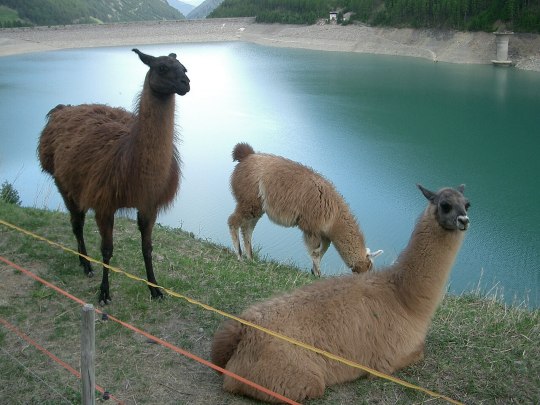
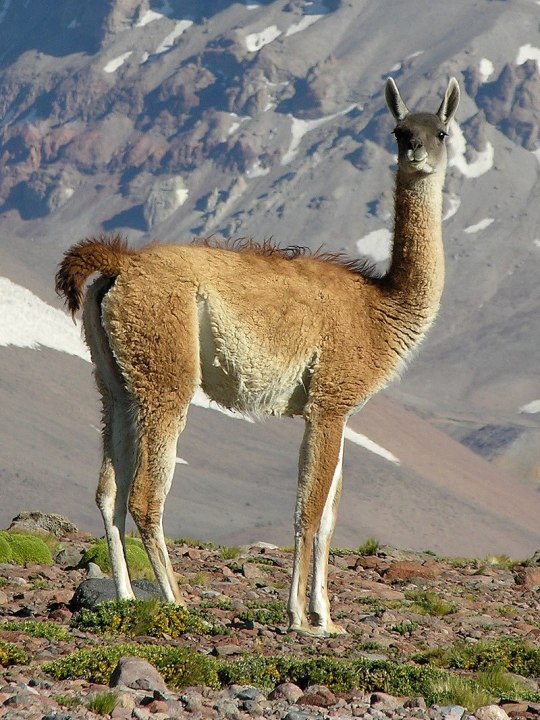


#poll#random poll#fun polls#poll time#my polls#tumblr polls#random polls#polls#fandom polls#tumblr poll#polls on tumblr#polls are fun#polls polls polls#camel#animal#llama#alpacas#alpaca#Camelinae#Bactrian camel#Camelus bactrianus#Wild Bactrian camel#Camelus ferus#Dromedary camel#Camelus dromedarius#Llama#Lama glama#Guanaco#Lama guanicoe#Alpaca
22 notes
·
View notes
Text

The vicuña (Lama vicugna) or vicuna (both /vɪˈkuːnjə/, very rarely spelled vicugna, its former genus name)is one of the two wild South American camelids, which live in the high alpine areas of the Andes, the other being the guanaco, which lives at lower elevations. Vicuñas are relatives of the llama, and are now believed to be the wild ancestor of domesticated alpacas, which are raised for their coats. Vicuñas produce small amounts of extremely fine wool, which is very expensive because the animal can only be shorn every three years and has to be caught from the wild. When knitted together, the product of the vicuña's wool is very soft and warm. The Inca valued vicuñas highly for their wool, and it was against the law for anyone but royalty to wear vicuña garments; today, the vicuña is the national animal of Peru and appears on the Peruvian coat of arms. Wikipedia
34 notes
·
View notes
Text

Submitted by @sky-fi-fangirl:
"Vicuña, Lama vicugna Maol. 1/16 natural size." Illus. Friedrich Specht. Brehms Tierleben, Small Edition 1927. Via Wikimedia Commons.
64 notes
·
View notes
Text
[ID: a presentation on domestic animals and what makes them domestic.
The first image contains text defining domestic animals as the ones that "have been selectively bred by humans for many generations to the point where they are genetically different from their wild ancestors". It also elaborates the difference between feral and genuinely wild animalsanimals, and tells that feral animals can be harmful for the environment they are released into, as well as that wild animals are less ethical pets than domestic ones.
The following images are about particular animals. Each contains the common English and scientific Latin names and a picture for the domestic animal and its wild ancestor, as well basic information on when and where it was domesticated and purposes for which it is being bred.
It covers:
Domestic Dog (Canis familiaris). Bred for: hunting, herding, pulling loads, protection, guarding livestock, racing, blood sport, meat, companionship, scientific research, show. Breeds: ~360. Domesticated in: ~13, 000 BC Siberia. Wild ancestor: Pleistocene Wolf (Canis lupus).
Domestic Cat (Felis catus). Bred for: pest control, companionship, scientific research, show. Breeds:~73. Domesticated in: ~7,500 BC Western Asia. Wild ancestor: African Wildcat (Felis lybica).
Ferret (Mustela furo). Bred for: hunting rabbits, companionship, scientific research. Breeds: 1. Domesticated in: ~500 BC Mediterranean Region. Wild ancestor: European Polecat (Mustela putorius).
Cattle (Bos taurus). Bred for: meat, milk, hides, pack, riding, driving, blood sport, companionship. Breeds: ~1000. Domesticated in: ~8,500 BC Mediterranean Region and India. Wild ancestor: Aurochs (Bos primigenius)(extinct) .
Sheep (Ovis aries). Bred for: meat, milk, skin, wool. Breeds: ~1000. Domesticated in: 11, 000~9, 000 BC Mesopotamia. Wild ancestor: Mouflon (Ovis gmelini).
Goat (Capra hircus). Bred for: meat, milk, skin, hair, companionship. Breeds: ~300. Domesticated in: ~8, 000 BC Iran. Wild ancestor: Wild Goat (Capra aegagrus).
Horse (Equus ferus caballus). Bred for: pack, riding, driving, meat, hair, racing, companionship. Breeds: ~300. Domesticated in: ~8, 000 BC Eurasia. Wild ancestor: Wild Horse (Equus ferus) (extinct).
Donkey (Equus asinus). Bred for: pack, riding, driving, guarding livestock, companionship. Breeds: ~100. Domesticated in: 5,000~3, 000 BC Nubia. Wild ancestor: African Wild Ass (Equus africanus) (critically endangered).
Dromedary Camel (Camelus dromedarius). Bred for: pack, riding, meat, milk. Breeds: 1. Domesticated in: 4,000~2, 000 BC Arabia. Wild ancestor: Wild Dromedary Camel (Camelus dromedarius?) (extinct).
Bactrian Camel (Camelus bactrianus). Bred for: pack, riding, meat, milk, wool. Breeds: 1. Domesticated in: ~4,500 BC Mongolia and China. Wild ancestor: Unknown (extinct).
Llama (Lama glama). Bred for: pack, meat, fiber, guarding livestock. Breeds: 1. Domesticated in: 5,000~4, 000 BC Peru. Wild ancestor: Guanaco (Lama guanicoe).
Alpaca (Lama pacos). Bred for: fiber. Breeds: 2. Domesticated in: 5,000~4, 000 BC Peru. Wild ancestor: Vicuna (Lama vicugna).
Domestic Rabbit (Oryctolagus cuniculus domesticus). Bred for: meat, fur, companionship, scientific research. Breeds: ~300. Domesticated in: 1~1, 500 AD Rome. Wild ancestor: European Rabbit (Oryctolagus cuniculus).
Guinea Pig (Cavia porcellus). Bred for: meat, companionship, scientific research. Breeds: 14. Domesticated in: ~5, 000 BC Andean Region. Wild ancestor: Montane Guinea Pig (Cavia tschudii).
Fancy Rat (Rattus norvegicus domestica). Bred for: blood sport, companionship, scientific research, show. Breeds: 1. Domesticated in: ~1750 AD Europe. Wild ancestor: Brown Rat (Rattus norvegicus).
Fancy Mouse (Mus musculus domestica). Bred for: show, scientific research, companionship. Breeds: 1. Domesticated in: ~1, 000 BC China. Wild ancestor: House Mouse (Mus musculus).
Pig (Sus domesticus). Bred for: meat, companionship, scientific research. Breeds: ~300. Domesticated in: ~9, 000 BC Mesopotamia and ~6, 000 BC China. Wild ancestor: Wild Boar (Sus scrofa).
Domestic Pigeon (Columbia livia domestica). Bred for: meat, message carrying, racing, show, companionship. Breeds: ~800. Domesticated in: ~8, 000 BC Mesopotamia. Wild ancestor: Rock Dove (Columbia livia).
Domestic Turkey (Meleagris gallopavo domesticus). Bred for: meat. Breeds: ~21. Domesticated in: ~12 AD Mexico. Wild ancestor: Wild Turkey (Meleagris gallopavo).
Chicken (Gallus gallus domesticus). Bred for: meat, eggs, show, companionship. Breeds: ~100. Domesticated in: ~6, 000 BC Southeast Asia. Wild ancestor: Red Junglefowl (Gallus gallus).
Domestic Duck (Anas platyrhynhos domesticus). Bred for: meat, eggs, show, companionship. Breeds: ~220. Domesticated in: 600~500 BC China. Wild ancestor: Mallard (Anas platyrhynhos).
Domestic Muscovy Duck (Cairina moschata domestica). Bred for: meat. Breeds: 1. Domesticated in: ~50 AD Peru. Wild ancestor: Muscovy Duck (Cairina moschata).
Domestic Goose (Anser anser domesticus). Bred for: eggs, meat, feathers, guarding livestock, companionship. Breeds: ~30. Domesticated in: 3,000~1, 980 BC Egypt. Wild ancestor: Greylag Goose (Anser anser).
Chinese Goose/African Goose (Anser cygnoides domesticus). Bred for: eggs, meat, feathers. Breeds: 2. Domesticated in: 1,000 BC~1800 AD China. Wild ancestor: Swan Goose (Anser cygnoides).
Coturnix Quail (Coturnix japonica). Bred for: song, eggs, meat. Breeds: 11. Domesticated in: ~1, 200 AD Japan. Wild ancestor: Japanese Quail (Coturnix japonica).
Domestic Guineafowl (Numida meleagris). Bred for: pest control, guarding livestock, meat, eggs. Breeds: 1. Domesticated in: ~500 BC West Africa. Wild ancestor: Helmeted Guineafowl (Numida meleagris).
Domestic Canary (Serinus canaria domestica). Bred for: song, display, CO detection, companionship. Breeds: ~200. Domesticated in: ~1650 AD Europe. Wild ancestor: Atlantic Canary (Serinus canaria).
Axolotl (Ambystoma mexicanum). Bred for: scientific research, meat, display. Breeds: 1. Domesticated in: ~1879 AD France. Wild ancestor: Wild Axolotl (Ambystoma mexicanum) (critically endangered).
Siamese Fighting Fish/Betta (Betta splendens). Bred for: blood sport, display. Breeds: 1. Domesticated in: ~1020 AD Thailand. Wild ancestor: Siamese Fighting Fish/Betta (Betta splendens).
Goldfish (Carassius auratus). Bred for: display. Breeds: ~200. Domesticated in: ~1020 AD China. Wild ancestor: Crucian Carp (Carassius carassius).
Domestic Silk Moth (Bombyx mori). Bred for: silk. Breeds: 1. Domesticated in: ~3, 000 BC China. Wild ancestor: Wild Silk Moth (Bombyx mandarina).
Western Honey Bee (Apis mellifera). Bred for: crop pollination, honey, beeswax. Breeds: 1. Domesticated in: 7,000~3, 000 BC Egypt. Wild ancestor: European Honey Bee (Apis mellifera).
The last image is explaining what a breed is ("is was selectively bred by humans to look and/or behave a certain way"), and tells some breeds are less ethical than the others due to being bred for aesthetics at the expense of health.
End ID. ]

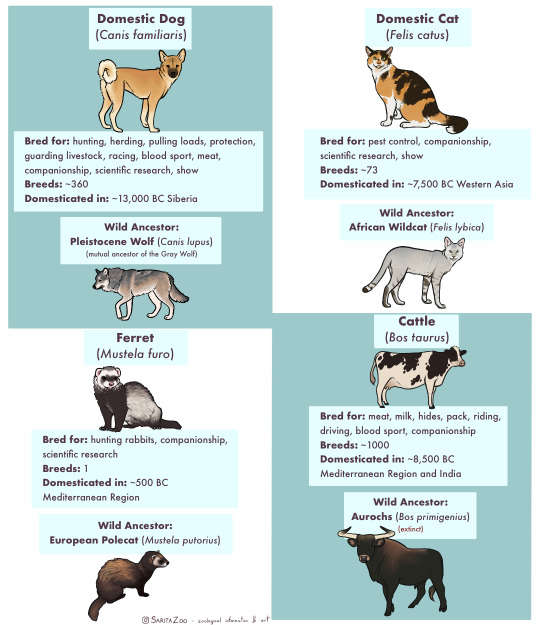


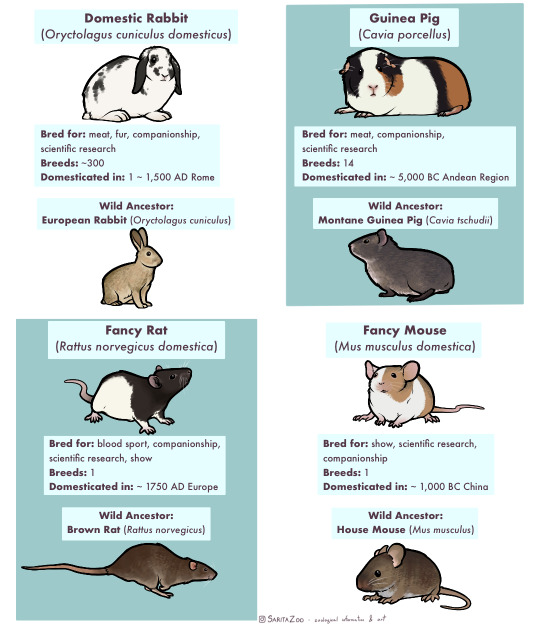
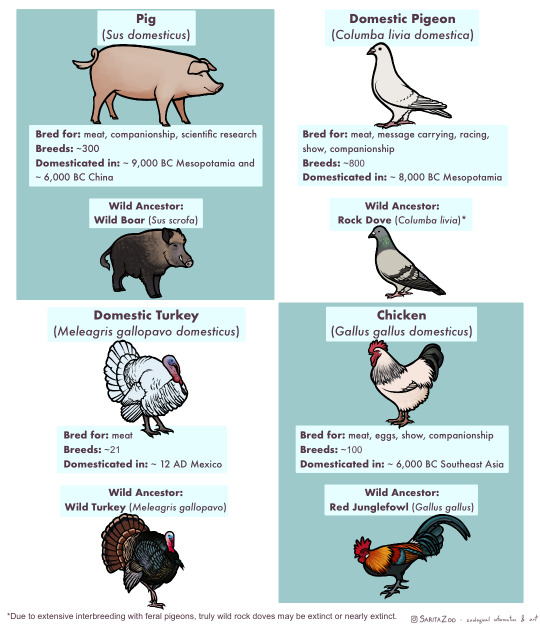
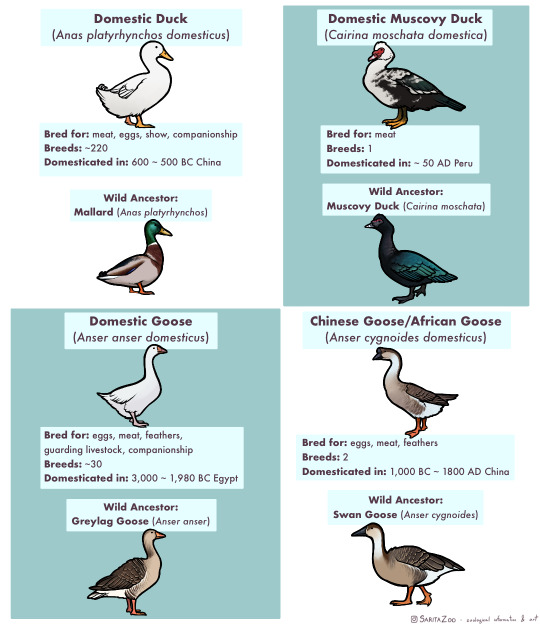
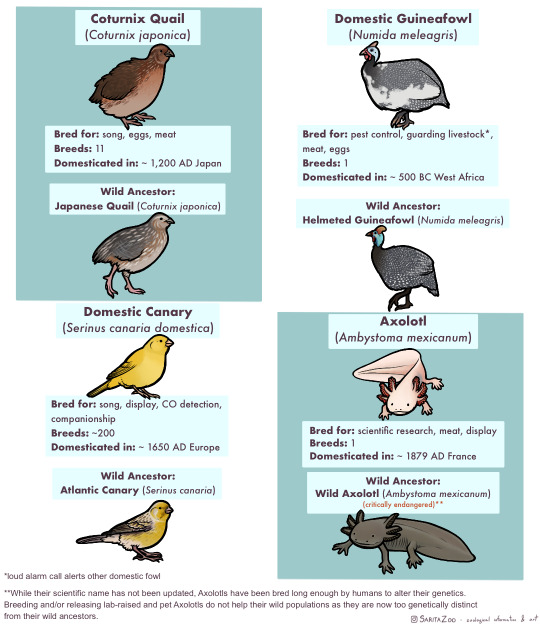
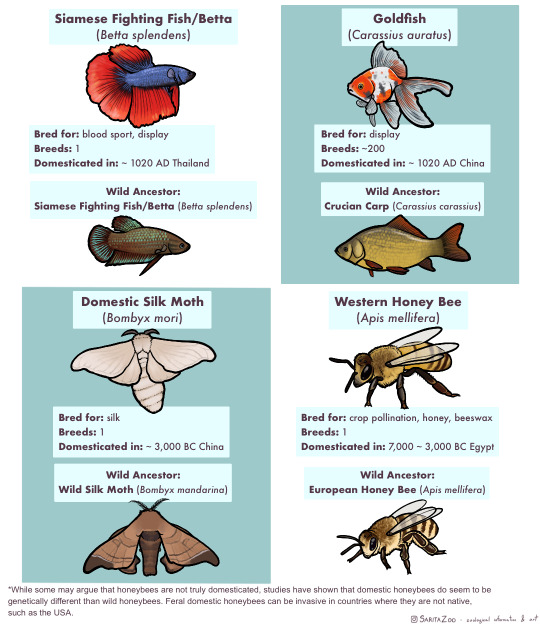

Phew. This one took, uh… a bit longer than expected due to other projects both irl and art-wise, but it’s finally here. The long-awaited domestic animal infographic! Unfortunately, I didn’t have enough space to cover every single domestic animal (I’m so sorry, reindeer and koi, my beloveds) but I tried to include as many of the “major ones” as possible.
I made this chart in response to a lot of the misunderstandings I hear concerning domestic animals, so I hope it’s helpful!
Further information I didn’t have any room to add or expand on:
🐈 “Breed” and “species” are not synonyms! Breeds are specific to domesticated animals. A Bengal Tiger is a species of tiger. A Siamese is a breed of domestic cat.
🐀 Different colors are also not what makes a breed. A breed is determined by having genetics that are unique to that breed. So a “bluenose pitbull” is not a different breed from a “rednose pitbull”, but an American Pitbull Terrier is a different breed from an American Bully! Animals that have been domesticated for longer tend to have more seperate breeds as these differing genetics have had time to develop.
🐕 It takes hundreds of generations for an animal to become domesticated. While the “domesticated fox experiment” had interesting results, there were not enough generations involved for the foxes to become truly domesticated and their differences from wild foxes were more due to epigenetics (heritable traits that do not change the DNA sequence but rather activate or deactivate parts of it; owed to the specific circumstances of its parents’ behavior and environment.)
🐎 Wild animals that are raised in human care are not domesticated, but they can be considered “tamed.” This means that they still have all their wild instincts, but are less inclined to attack or be frightened of humans. A wild animal that lives in the wild but near human settlements and is less afraid of humans is considered “habituated.” Tamed and habituated animals are not any less dangerous than wild animals, and should still be treated with the same respect. Foxes, otters, raccoons, servals, caracals, bush babies, opossums, owls, monkeys, alligators, and other wild animals can be tamed or habituated, but they have not undergone hundreds of generations of domestication, so they are not domesticated animals.
🐄 Also, as seen above, these animals have all been domesticated for a reason, be it food, transport, pest control, or otherwise, at a time when less practical options existed. There is no benefit to domesticating other species in the modern day, so if you’ve got a hankering for keeping a wild animal as a pet, instead try to find the domestic equivalent of that wild animal! There are several dog breeds that look and behave like wolves or foxes, pigeons and chickens can make great pet birds and have hundreds of colorful fancy breeds, rats can be just as intelligent and social as a small monkey (and less expensive and dangerous to boot,) and ferrets are pretty darn close to minks and otters! There’s no need to keep a wolf in a house when our ancestors have already spent 20,000+ years to make them house-compatible.
🐖 This was stated in the infographic, but I feel like I must again reiterate that domestic animals do not belong in the wild, and often become invasive when feral. Their genetics have been specifically altered in such a way that they depend on humans for optimal health. We are their habitat. This is why you only really see feral pigeons in cities, and feral cats around settlements. They are specifically adapted to live with humans, so they stay even when unwanted. However, this does not mean they should live in a way that doesn’t put their health and comfort as a top priority! If we are their world, it is our duty to make it as good as possible. Please research any pet you get before bringing them home!
33K notes
·
View notes
Text
Alpaca Wisdom
The alpaca (Vicugna pacos) is often mistaken for llamas (Lama glama) and is the smallest member of the camel family. Despite their resemblance to llamas, alpacas have distinct characteristics such as smaller muzzles and ears. They are primarily bred for their luxurious, hypoallergenic fleece and can be found across the globe, excluding Antarctica. There are two main alpaca breeds, Huacaya and…

View On WordPress
0 notes
Text

VICUNA!
Lama vicugna
Wild South American camillids
Live in alpine areas at lower elevations
Produce extremely fine wool
Can only be shorn every three years,
has to be caught in the wild!
Very shy animal
Licks stones and rocks rich in salt content
Mammals ... Wikipedia facts
0 notes
Photo

Descubren anticuerpos en Alpacas que podrían neutralizar el Coronavirus SARS-CoV-2 La aparición del Coronavirus SARS-CoV-2 que genera la enfermedad infecciosa del COVID-19, ha puesto a la Organización Mundial de la Salud (OMS) en una carrera contra el tiempo para encontrar una vacuna que frene el número de contagios y muerte alrededor del mundo.
#Alpaca#animales#Camelidae#COVID-19#Lama guanicoe#Novel Coronavirus SARS-CoV-2#Vacuna contra el Covid-19#Vicugna pacos
0 notes
Text
procedo a colaborar con animalitos del Norte

Vicuña- Lama vicugna

Llama- Lama glama

Carancho- Caracara plancus

Chimango- Daptrius chimango

Cóndor andino- Vultur gryphus
No soy furro, pero creo que los furros latinoamericanos deberían dibujar fauna autóctona en vez de lobos y zorros y esas cosas
621 notes
·
View notes
Photo

Você conhece os Camelídeos Sul-Americanos?❓ ✔Guanaco (Lama guanicoe); ✔ Lhama (Lama glama); ✔ Vicunha (Vicugna vicugna); ✔ Alpaca (Vicuna pacos). ⠀ 📸 Nessas fotos temos qual deles? ❓ 📌 Uma curiosidades sobre os camelídeos sul-americanos Todos eles defecam e urinam em 'pilhas de estercos comunitárias', do seu bando ou de outro, que podem ter trinta centímetros de espessura e quatro metros de diâmetro. A nível ecológico, sabe-se que no lugar dessas pilhas de fezes e xixi, após a temporada de chuvas, cresce uma vegetação verde e brilhante que se destaca na aridez da puna. (Fonte: https://www.peritoanimal.com.br/diferencas-entre-alpaca-e-lhama-23183.html) ⠀ ⠀ 📍 RN 52 - Argentina 🇦🇷 ⠀ #guanaco #lhama #vicunha #alpaca #camelideos #americadosul #southamerica #ruta52 #altitude #argentina #chile #peru #bolivia #montanha #montana #natureza #peritoanimal #nature #roadtrip #photography #fotooriginal #semfiltro #cordilheiradosandes #cordillera #andes #viajarsempre #terrasemfim (em Ruta Nacional N°52) https://www.instagram.com/p/CN8Y7w9JjJu/?igshid=xu2ow7a5rcmr
#guanaco#lhama#vicunha#alpaca#camelideos#americadosul#southamerica#ruta52#altitude#argentina#chile#peru#bolivia#montanha#montana#natureza#peritoanimal#nature#roadtrip#photography#fotooriginal#semfiltro#cordilheiradosandes#cordillera#andes#viajarsempre#terrasemfim
3 notes
·
View notes
Video
tumblr
Schurftbehandeling bij alpaca's
Alpaca's (Vicugna pacos) behoort tot de kleine kameelachtigen uit Zuid-Amerika. en is de gedomesticeerde variant van de lama, die leeft in het Andes, het hooggebergte in Chili en Peru. De alpaca wordt in Nederland voor de hobby gehouden als park- en / of erfdier. Ze worden 1 x per jaar of 1 x per twee jaar geschoren. Ze behoren tot de herkauwers en hebben geen tanden in de bovenkaak.
Alpaca’s zijn gevoelig voor schurft, een huidparasiet, die leeft in de haarzakjes.
Dierenarts Peter Klaver is verzocht om een alpaca te behandelen tegen schurft.
Voor meer informatie of een afspraak: tijdens kantooruren tel 0488-410040 of mail [email protected] of on line: https://www.personalcard.nl/agenda?klaver4dieren
0 notes
Text
Llamas and alpacas carry genes from mysterious ‘ghost’ relatives
Llamas and alpacas carry genes from mysterious ‘ghost’ relatives
By Michael Marshall Adult guanacos (Lama guanicoe) in southern Chile, South America Wayne Lynch/Alamy Domestic llamas and alpacas carry DNA from an extinct “ghost” population of their wild camelid relatives. Furthermore, their domestication may have involved interbreeding between two different species. Domestic llamas (Lama glama) and alpacas (Vicugna pacos) were crucial for South American…

View On WordPress
0 notes
Photo

Друзья, давайте поговорим об альпаках. Красивые, грациозные животные. Первоначально альпак ошибочно относили к роду лам, однако в 2001 году систематику вида сменили с Lama pacos на Vicugna pacos, выяснив, что предками альпака были викуньи, а не гуанако, прародители всех домашних лам. В Новой Зеландии разводят альпак двух видов – уакая и сури. Они отличаются и по внешнему виду – сури немного крупнее и длинношеее и еще ушки у них растут по-разному )) Ну и конечно главное и наиболее интересующее нас рукодельниц отличие, это шерсть. У альпаки сури шерсть вырастает длиннее, волокно гладкое с деликатным люстровым блеском, прямое у основания, переходящее в легкий извив и иногда сильно кудрявое ближе кончикам, этот эффект кудрявости сильнее выражен у молодых животных в первой стрижке. На моем фото те локоны, что ближе к линейке это как раз первая стрижка молодого животного. Алпака уакая (та что слева) по структуре волокна напоминает меринос – то же штапельное строение волокна. Но бывает альпака уакая со слабовыраженным извивом, почти прямым локоном. У альпак богатая цветовая палитра. Зачастую в шкурке одного животного могут встречаться две-три цветовые вариации. Тонина шерсти тоже немного варьируется. Шерсть альпак - и сури и уакая широко используется в рукоделии. Но если Вы начинающий валяльщик, готовьтесь – шерсть альпаки не так просто «приручить», надо много практиковаться, но за то, когда вы поймете эту шерстку из ваших рук будут выходить изысканные вещи. Как например на фото работ моих любимых мастеров Оли Цхай и Ирины Демченко. Пишите в комментариях, как вы думаете какие флисы альпак использованы в этих работах? Шерстка альпк уакая и сури, как видите, отлично подойдут для эко меха. Так же флис алпак можно использовать и для фактурного войлока. Хороша альпака и для прядения. У меня в магазине предложена кардированная альпака уакая – прекрасно прядется, а также и валяется. Шерстку сури, поскольку она гладкая и скользкая хорошо бы смешать с шерстью тонкорунных пород овец и уже из этой смеси делать пряжу. https://www.instagram.com/p/B72KAY8FR2B/?igshid=1v9yfpk3qhjnv
0 notes
Note
Your rant about lamas got me thinking that maybe some members of camel family should be reclassified. For glavin out the Cama hybrid can produce fertile offspring and yet the mule can't! If many species of Pleistocene horse can fit in Equus then maybe both new world and old world camels could fit into one genus. At very least both Lama and Vicugna should be merged into one genus. I also feel same with the genus bison and bos. But that's just my opinion and won't go full Peters or anything.
I agree; mammalologists really need to get it together.
22 notes
·
View notes
Text
Ve výběhu jihoamerických zvířat v Zoologické zahradě a botanickém parku Ostrava je k vidění několik mláďat lam alpak. Nejstarší je sameček, který se narodil 1. června. Další dvě jsou samičky, jedna přišla na svět 29. července, druhá 22. srpna. Všechna mláďata jsou krátce po porodu schopna vstát a následovat svou matku. První krůčky však bývají na vratkých nohách ještě nejisté, ale zanedlouho už malé lamy sebejistě běhají po výběhu. V ostravské zoo se lamy rozmnožují pravidelně a podařilo se zde odchovat již desítky mláďat. Současná mláďata spolu s dalšími obyvateli výběhu nandu pampovými zachycuje video.
Lamy jsou nejbližšími příbuznými velbloudů. Dnes obývají Jižní Ameriku, kde žijí dva divoké druhy – hojnější lama guanako (Lama guanicoe) obývající rozlehlé pampy i hory do výšky 4800 m n. m. a vzácnější lama vikuňa (Lama vicugna) obývající náhorní roviny ve výškách 3500 až 5800 m n. m. Potomky guanaka jsou dvě domácí formy – lama krotká a alpaka. Lamy domestikovali Inkové před 6000 až 7000 lety v Peru v okolí jezera Titicaca. Pasou se převážně na šťavnatých pastvinách. Potravu přežvykují, ale žaludek mají pouze třídílný. Samice lamy vrhá jedno mládě, které poměrně dlouho kojí. Starší mláďata z předešlého vrhu tedy často sají s mláďaty mladšími. Lamy se dokážou velmi rychle aklimatizovat při změnách nadmořské výšky. Proto se hodí pro vynášení nákladů více než koně.
Alpaky a nandu pampoví_foto M.Vlčková
Mládě lamy alpaky_foto M.Vlčková
Alpaka (Lama guanicoe f. pacos) je menší zdomácnělou formou. Zbarvení srsti bývá bílé, černé, hnědé, béžové, šedé nebo strakaté. Je chována pro mléko, maso a vlnu. Ta se jemností podobá prachovému peří a ročně jí lze z jedné lamy získat 2-3 kg. Většinou se ale stříhají co dva roky. K nošení břemen se alpaky vzhledem k velikosti využívají jen minimálně, nepoužívají se ani jako jezdecká ani jako tažná zvířata.
Mláďata alpak v Zoo Ostrava Ve výběhu jihoamerických zvířat v Zoologické zahradě a botanickém parku Ostrava je k vidění několik mláďat lam alpak.
0 notes